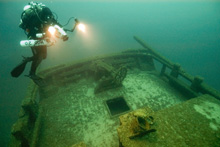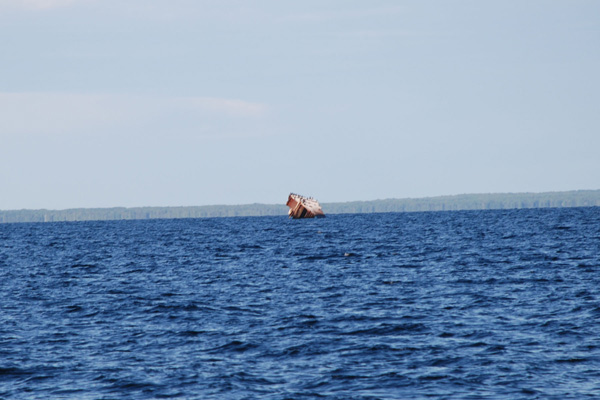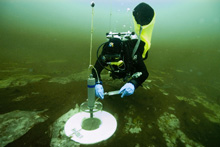Thunder Bay National Marine Sanctuary (TBNMS) diver Russ Green explores the wreck of the 19th century schooner Barney. Click image for larger view and image credit.
Scientific and Recreational Diving in TBNMS
September 11, 2008
Emily McDonald
Web Coordinator
NOAA Office of Ocean Exploration
Thunder Bay National Marine Sanctuary (TBNMS) is primarily known for its vast number of shipwrecks. An estimated 200 shipwrecks reside within and just outside the sanctuary's waters. These wrecks range from nineteenth century lake schooners and paddle boats to perhaps Thunder Bay's last wreck, the German freighter Nordmeer, which wrecked near Thunder Bay Island in 1966.
Each year hundreds of recreational divers come to TBNMS and brave the chilly waters of Lake Huron for a chance to glimpse sunken history. In addition to the recreational divers, the sanctuary has a team of scientific and archaeological divers working to protect, preserve, and learn more about the sanctuary's known wrecks as well as to research and explore for undiscovered wrecks.
A part of the German freighter Nordmeer still protrudes from the waters of Lake Huron in the TBNMS. Click image for larger view and image credit.
At the Middle Island Sinkhole, TBNMS diver Joe Hoyt sets up a respiration chamber experiment near the purple microbial mats. Click image for larger view and image credit.
Scientific diving requires additional skills and training above and beyond what is required for a typical recreational diver. While diving to depths greater than 30 meters (98 feet) can be considered advanced for a recreational diver, imagine having to dive to that depth (and even deeper) to set up equipment or take samples!
The chilly water temperatures of Lake Huron also require divers to use dry-suits almost all year long. Water near the bottom of the Middle Island Sinkhole in early September is a brisk 3.3º C (38º F)!
TBNMS divers have played an important role in sinkhole exploration. Scientists depend on the divers to collect samples of the purple and white microbial mats at the bottom of the sinkholes and to deploy and position instrumentation, such as the respiration chambers and tripods, for accurate data collection. Divers also provide underwater photographs and video of the sinkholes.
Sign up for the Ocean Explorer E-mail Update List.




















